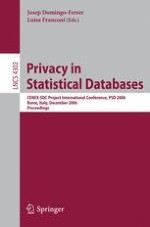Privacy in statistical databases is a discipline whose purpose is to provide - lutions to the con?ict between the increasing social, political and economical demand of accurate information, and the legal and ethical obligation to protect the privacy of the individuals and enterprises to which statistical data refer. - yond law and ethics, there are also practical reasons for statistical agencies and data collectors to invest in this topic: if individual and corporate respondents feel their privacyguaranteed,they arelikelyto providemoreaccurateresponses. There are at least two traditions in statistical database privacy: one stems from o?cial statistics, where the discipline is also known as statistical disclosure control (SDC), and the other originates from computer science and database technology.Bothstartedinthe1970s,butthe1980sandtheearly1990ssawlittle privacy activity on the computer science side. The Internet era has strengthened the interest of both statisticians and computer scientists in this area. Along with the traditional topics of tabular and microdata protection, some research lines have revived and/or appeared, such as privacy in queryable databases and protocols for private data computation.
